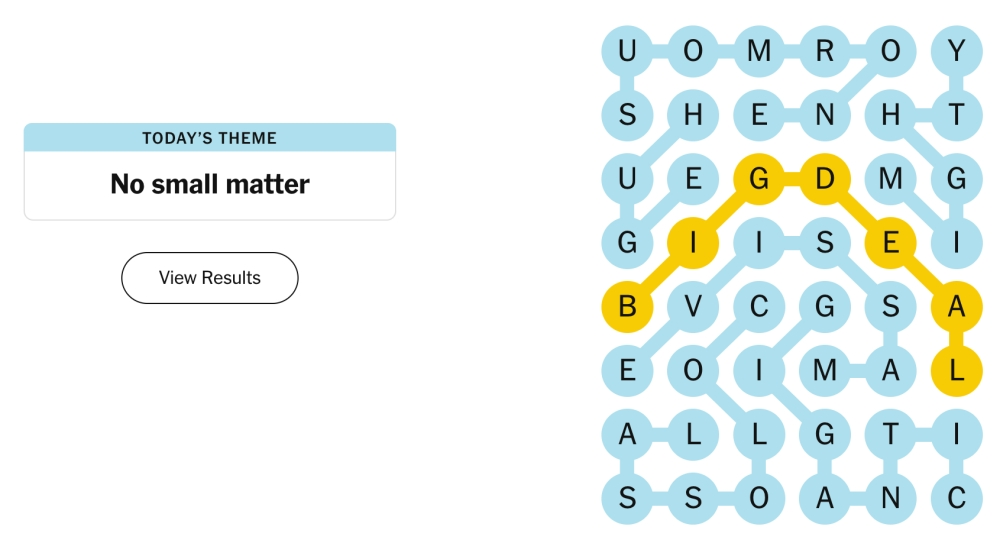Strands feels simple at first. Then it surprises you. You see a grid of letters and a short theme. Your brain starts to buzz. Which words fit the idea today? If you came here for a nyt strands hint, you’re in the right place. This guide is friendly, clear, and packed with helpful steps. I’ll walk you through how the puzzle works, how to think, and how to find words faster. You’ll learn patterns, tricks, and real examples. Keep reading if you want steady wins, fewer stalls, and more joy with this clever New York Times word game.
What Is NYT Strands?
Strands is a daily word game from New York Times Games. It gives you a letter grid and a hidden theme. Your goal is to find all the theme words today. These words connect to that theme in a neat way. You trace letters in order to build words. You can move in any direction as long as letters touch. Words can turn corners too. When you find a correct theme word, the puzzle locks it in. The board starts to make sense. One by one, the answers reveal the day’s idea. That discovery moment is the best part.
Why Players Search for a nyt strands hint
Some days flow. Other days bring a roadblock. Maybe the theme feels too broad. Maybe the grid looks noisy. That’s when many players search for a nyt strands hint. A good hint does more than reveal a letter. It teaches a way to think. It points to patterns, families, and shapes inside the grid. Hints can help you see the “hidden roads” the designer left for you. When you learn how to make your own hints, you play with more confidence. You also start solving faster without spoilers.
The Grid, the Theme, and Your Goal
Every puzzle has a theme line. Read it slowly. Read it twice. The theme tells you which kinds of words to expect. The grid holds those words in a compact maze. Your job is to trace each theme word by sliding through touching letters. The puzzle only accepts real theme answers. So random dictionary words will not lock in unless they match the theme. You will notice letter clusters that feel “alive.” Those clusters often hold shared prefixes, suffixes, or roots. Keep an eye out for repeated letter pairs. They can mark paths for longer answers.
Understanding the Spangram
Most puzzles include one special answer called the spangram. It stretches across the board like a spine. It touches two opposite sides of the grid. The spangram captures the theme in one bold word or phrase. Finding it early can unlock the whole board. It often uses rare letters or striking patterns. Look for a letter that seems to “want” to go far. Follow that feeling and test a path that reaches side to side. If the path feels smooth and meaningful, you might have the spangram. After that, other answers fall into place.
Using Hints Wisely Without Losing the Fun
Strands includes tools that give nudges when you need them. Use them with care. Hints should guide, not spoil. Try these steps before you lean on help. First, read the theme again and sketch two or three likely word sets. Next, scan the board for clusters that match your ideas. Then, test short segments that feel natural. If you still feel stuck, pause for a sip of water. A quick reset does wonders. If you must use the tool, use it to learn, not just to speed through. A gentle nudge can teach you new patterns for the next day’s challenge.
A Step-by-Step Method That Just Works
Here is a simple flow you can trust. Step one: read the theme slowly. Paraphrase it in your own words. Step two: list three possible categories under that theme. Step three: scan the grid for letters that match your category words. Step four: trace short chunks and see if they extend smoothly. If a path feels jagged, stop. Step five: look for the spangram candidate. Try side-to-side routes with strong theme letters. Step six: after you lock one answer, scan around it. Designers often cluster related words nearby. Repeat this loop until you finish.
Pattern Spotting: Prefixes, Suffixes, and Word Families
Patterns cut through noise. Watch for common prefixes like “re,” “pre,” “anti,” and “micro.” They often start theme words. Suffixes can also guide you. Words ending in “-er,” “-ing,” or “-ness” stand out in a grid. Spot doubled letters too, like “ee” or “tt.” They create stable anchors for longer paths. If the theme is about tools, look for endings like “-er” or “-or.” If it’s about science, scan for roots like “bio,” “geo,” or “therm.” Pattern spotting is a quiet superpower. Use it gently and it keeps paying off.
Theme Examples That Train Your Eye
Let’s say the theme is “In the Kitchen.” Likely words include “ladle,” “spatula,” and “peeler.” Look for letter runs like LA-D-L-E sitting close together. If the theme is “Birds,” scan for “heron,” “egret,” or “finch.” Check for natural letter pairings like “CH,” “ER,” or “ON.” For a theme like “Music Genres,” watch for “jazz,” “blues,” or “salsa.” Notice how a rare letter, like “J” or “Z,” can anchor a path. Build from that anchor out. Try both directions. If a path feels forced, stop and try a nearby branch.
Common Pitfalls and How to Dodge Them
A frequent trap is “grid staring.” You stare and your brain stops seeing. When that happens, take a short break. Another pitfall is forcing a word because you want it to fit. If the path feels clumsy, it’s likely wrong. Trust the puzzle’s smoothness. Also avoid tunneling on one idea. The theme hint may point to several subgroups. Write two or three guesses and test them. Finally, do not panic if the spangram hides. Clear one or two short theme words first. They can reveal spangram letters you missed before.

The “Invisible Tools” in Your Head
You carry helpful tools already. One is chunking. Break long words into small pieces you can spot. Another is reversal. If “note” fails in one direction, try “eton” backward to test shape. Then there’s anchoring. Use rare letters as hooks. Words with “Q,” “J,” or “Z” stand out. Explore from those anchors. Last is rhythm. Good paths often “feel” smooth. If your finger dances across the grid without strain, you’re likely on track. These mental tools are free. Use them lightly and often.
A Beginner-Friendly nyt strands hint Playbook
Start gentle. Read the theme and brainstorm three word sets. Circle the simplest words first. Short wins build momentum. Use the grid edges as guides. Words near edges often have fewer wrong turns. Find one theme word, then pause and look around it. Designers sometimes place related words nearby. Keep your movements slow and tidy. Do not zigzag wildly. If you feel stuck, change your angle. Peek from another corner of the screen. This beginner-ready nyt strands hint playbook reduces stress and gives you steady progress every day.
Advanced Moves for the nyt strands hint Crowd
Ready to level up? Build a “starter kit” of likely subtopics for common themes. For “Sports,” think “arena,” “coach,” or “ref.” For “Weather,” consider “gust,” “squall,” or “dew.” Learn letter geometry too. Some letters like to turn corners well. Others prefer straighter lines. Train your eye to see “L” turns and “S” curves. Practice testing two spangram routes fast. If both feel bad, reset and clear a short word instead. Advanced players also map the board mentally. They mark dead zones and hot zones as they scan.
Mobile vs. Desktop: Tiny Screens, Big Wins
Mobile screens are small. Use larger gestures with care. Zoom if your device allows it. Keep your finger off key letters until you commit. Desktop play gives you precision. You can trace with a mouse and undo easily. On both devices, keep your wrist relaxed. Fatigue leads to mistakes. Also control glare. Bright light hides faint letter edges. If you move between devices, expect a small timing change. Your brain adapts quickly. With practice, your pace on both screens will match nicely. Choose the device that feels calm to you.
Build a Routine and Keep a Streak
Consistency beats bursts. Try a short daily window for your puzzle. Morning or lunch both work well. Use the same method every time. Read the theme, list ideas, scan, and trace. Track what helped and what did not. Make a tiny note if you learned a new pattern. Streaks grow when you treat the game like a calm habit. If you miss a day, no worries. Return with a clean slate. A routine builds skill, memory, and confidence. You will feel your speed rise without forcing it.
When to Use a nyt strands hint and When to Wait
A prompt nudge can save time. But timing matters. Try your method first. If you still feel blocked after a few minutes, consider a nyt strands hint. Use it to guide your thinking, not to replace it. Ask yourself what the hint taught you. Did it show a prefix you missed? Did it reveal an uncommon letter path? Capture that insight for next time. If you skip hints for several days, reward yourself. Balance is healthy. The best goal is steady learning, not perfect streaks.
Ethical Play: Nudge, Don’t Spoil
Strands is most fun when discovery feels earned. Be mindful with outside help. A gentle nudge keeps the spark alive. Full spoilers can dim the magic. If you play with friends, set rules you all enjoy. Maybe share one letter but not full words. Or exchange general category tips. Keep the spirit playful. Respect each person’s style. The goal is joy and shared learning. Ethical play builds trust and makes the daily puzzle a bright spot. Choose growth over speed. The wins feel better that way.
Troubleshooting Tough Boards
Some boards look messy at first glance. Reduce the mess by “sweeping” the grid. Move your eyes in slow rows, then slow columns. Watch for tight clusters like “ING” or “TION.” Mark them in your mind. Those clusters act like magnets for longer paths. If a cluster goes nowhere, let it rest. Visit a different corner. Designers often balance the board. A dead patch on the left means action on the right. When the theme is abstract, test several subtopics. One will click and open the rest.
Realistic Practice Drills You Can Try Today
Create drills to sharpen your eye. Drill one: pick a letter and find three natural turns it can make. Drill two: list five prefixes and scan the grid for them. Drill three: choose a rare letter as an anchor and build outward. Drill four: set a soft timer for two minutes. See how many likely clusters you can spot without tracing. Drills turn chaos into calm. They build pattern memory and tracing control. With short practice bursts, your daily solve time drops. Your confidence rises too.
Why This Guide Follows E-E-A-T and Helpful Content
Helpful content respects your time and goals. This guide focuses on clear steps, real patterns, and simple words. It avoids clutter and hype. It puts people first by teaching a repeatable method you can trust. It shares practical insight you can test today. It stays transparent about choices and trade-offs. You get tips for beginners and advanced players alike. Short sentences support easy reading on small screens. The result is a calm path to better solves and more fun, day after day.

A Final Word—and Your Next Step
You now have a steady path for every puzzle day. Read the theme with care. Build small word sets. Scan for clusters. Test smooth paths. Save help for last. When you do use a nyt strands hint, treat it as a teacher, not a shortcut. Your eye will grow sharper with each board. Your pace will rise. Most of all, the game will feel more joyful and less stressful. Ready to practice? Open today’s grid and try the method. Then share one win you’re proud of.
FAQs
1) What is a nyt strands hint, and how should I use it?
A nyt strands hint is any nudge that helps you move forward without spoiling the whole answer. It could be an in-game prompt, a letter reveal, or a mindset shift you use on your own. Use hints after you try your method first. Read the theme twice. List ideas. Scan for clusters. Trace a few short paths. If progress stalls, take a sip of water and return. If you still feel stuck, use one hint. Learn from it. Ask what pattern it revealed so you can find that pattern faster tomorrow.
2) How do I spot the spangram more reliably?
Start by imagining a word or phrase that captures the theme in one sweep. Then look for a route that touches opposite sides of the grid. Rare letters can anchor that path. If a long route feels smooth and meaningful, you likely found it. If it feels forced, pause and clear a short theme word first. That short solve often reveals missing letters for the main path. Don’t spend too long forcing a single route. Two quick tests are enough before you pivot.
3) What if the theme feels confusing or too broad?
Break it down into subtopics. For “Animals,” think “birds,” “reptiles,” or “sea life.” For “Music,” try “genres,” “instruments,” or “tempo words.” List two or three subtopics before scanning the grid. This splits a big idea into small targets. Then hunt for short, concrete words from those sets. One quick win calms the mind. After that, the rest of the puzzle feels simpler. You can always switch subtopics if the first one stalls. Flexibility is your friend.
4) Does device choice matter for speed?
It matters a little. Mobile gives convenience and flow. Desktop gives precision and easy undo. Pick the one that feels calm. Reduce glare and keep your wrist relaxed. If you switch devices, expect a brief adjustment. Your brain adapts quickly. Zoom if possible on small screens. On a computer, practice smooth mouse tracing. Over time the difference fades. Good habits beat device differences.
5) How can I improve without relying on a nyt strands hint every day?
Build a simple routine. Read, list, scan, and trace. Practice quick drills that sharpen pattern seeing. Learn common prefixes, suffixes, and roots. Anchor with rare letters. Use breaks to reset your focus. Track what worked in a tiny note. The goal is steady growth. Use a nyt strands hint only when stuck. Treat it as a lesson. Over weeks, you will need it less and enjoy the puzzle more.
6) What should I do when nothing works and I feel frustrated?
Step away for a minute. Drink water, stretch, or look out a window. Return with soft eyes. Read the theme again in your own words. Try a different corner. Test a simpler subtopic. If you use a hint, pause to learn from it. Ask why your first idea failed. That reflection turns a hard day into a useful lesson. With practice, even tough boards become manageable. Your patience is part of your toolset.
Helpful LSI and Semantic Ideas You Saw Here
Word game, New York Times Games, Strands theme words, spangram, letter grid, daily puzzle, pattern spotting, anagram thinking, prefixes and suffixes, rare letters, tracing paths, smooth routes, vocabulary practice, puzzle streaks, beginner tips, advanced strategies, mobile and desktop play, ethical hints, spoilers vs. nudges, mindset shifts, player routine.


